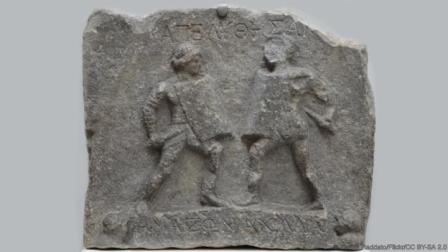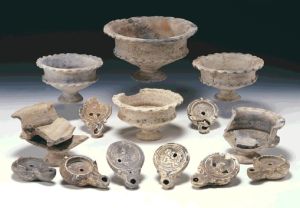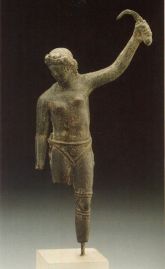When studying women in antiquity scholars often dismiss Roman female gladiators in their research due to the scarce and disputed amount of material and data regarding them. Although limited to our resources there are concrete and controversial evidence that these female gladiators existed and what their role in Rome’s society entailed.
It is unknown when female gladiators first appeared in Rome, but evidence suggests they emerged out of the rapid growth in popularity of games in the late Republican and Augustan eras.
Evidence that Female Gladiators existed?
Unfortunately, there are limited resources on female gladiators; they were uncommon and because of this not largely written about in antiquity. However, even if limited we do have a scarce amount of written and artistic sources that we can piece together to understand and characterize the roles and position of female gladiators.
The following historical quote from Antiquity is from Cassio Dios book of Roman History and is translated by Earnest Cary and Herbert Baldwin Foster. The succeeding quote is from Juvenals book Satire; which is translated by Niall Rudd.
“There was another exhibition that was once most disgraceful and most shocking, when men and women not only of the equestrian but even of the senatorial order appeared as performers in the orchestra, in the Circus, and in the hunting-theatre [Colosseum], like those who are held in lowest esteem. Some of them played the flute and danced in pantomimes or acted in tragedies and comedies or sang to the lyre; they drove horses, killed wild beasts and fought as gladiators, some willingly and some sore against their will.”
“What sense of shame can be found in a woman wearing a helmet, who shuns femininity and loves brute force… If an auction is held of your wife’s effects, how proud you will be of her belt and arm-pads and plumes, and her half-length left-leg shin guard! Or, if instead, she prefers a different form of combat, how pleased you’ll be when the girl of your heart sells off her greaves! Hear her grunt while she practices thrusts as shown by the trainer, wiling under the weight of the helmet.”
These historical quotes play an immense role in the history of female gladiators. The fact that we have literary evidence describing female gladiators showcases their existence is evidently undeniable.
Also, is his writing, Cassius Dio, reported that Septimius Severus banned performances by women (75.16.1). It’s not exactly clear how this happened or why but it seemed the ban was because of noblewomen being slandered, not Severus’ having an objection to women performing. It is not clear what the ban involved entirely, Dio’s report is skewed – but it seems that the ban was to keep these women from performing in a gymnastic competition. We can conclude that Severus’ was aiming at keeping these women from competing as athletes which could have impacted female gladiators. Since this report is at times distorted it is not as valuable to researchers, but still noteworthy.
Artistically speaking, there are a few depictions of female gladiators that have been found. Most notably is the relief sculpture from Halicarnassus showing the gladiators Amazon and Akhillia. Brunet describes the piece for us;
“The inscription indicates that they have been granted a mission in their combat. They are shown facing each other and to the degree, we can tell (the figure on the right has surfaced damage), they were both armed with shields, graves, swords, and manicae to protect their sword arms. Since the figure on the right is presumably Akhilla, fought left-handed, she wore her manica on her right side. The breasts of both gladiators, or at least the right breast of the figure on the left, were not covered. As well, they were not shown wearing helmets, which has led several scholars to claim that they in fact never wore helmets during their match.” (p. 163).

Underlying this claim is the presumption that they did not need helmets since they were simply playing at being gladiators in a parody of their male counterparts. The lack of helmets certainly goes against what would have been viewed as normal at the time. Only retiarii fought without a helmet. Upon further investigation of this photo, experts say the helmets are in fact in the photo; they are off to the side on the ground. Still, it is questioned why the helmet is absent from their head during combat.
Another indication that there was a sparse female gladiatorial presence is the lack of evidence discovered about them. Out of the immense number of artifacts found (vases, lamps, artworks, reliefs) pertaining to gladiatorial combat, we only possess a single artistic representation of female gladiators (as described above). These findings lead us to believe that this practice must have been rare due to the lack of depictions and even literary sources pertaining to female gladiators.
Were Female Gladiators a common practice?
As mentioned above, female gladiators were quite rare – it was not often you saw women fighting in the arena; when women did compete against animals or other women it was a massive event. Romans found it very interesting to watch women who were not usually portrayed as strong and brave demonstrate warrior skills.
“There was no specific Latin word for a female gladiator, nor did a feminine form of gladiator (i.e., gladiatrix) exist. Luda, the feminine form of Luda, the feminine form of ludio or ludius (“stage performer”), is the closest option; according to the Oxford Latin Dictionary it refers to a female slave attached to a gladiatorial ludas” (McCullough, p. 198). This showcases to us just how uncommon and rare it was to see female gladiators; they didn’t even have a name for them. It was a very uncommon practice – but not so rare that we have no evidence about it!
What did Female Gladiators do?
There is a lot of speculation around female gladiators – were they true gladiators? Did they even fight? Were they just there for show or humor? The word ‘gladiator’ normally suggests someone who is under contract and trained to fight in an arena. Often ancient and modern sources use the term loosely to describe any individual in the arena, including those with no skill (untrained) or protection (weapons/armor). Because of this, it makes it difficult to understand what the term gladiator actually meant and what it encompassed.
However, since the Latin language lacked a specific word for “female gladiator,” Roman authors had to take longer routes to describe women in the arena; therefore, they often revealed details of “these women’s actions in the arena, status, and/or the circumstances of their involvement (i.e., voluntary vs. compelled)” (McCullough, 2008, pp. 206). As a result, scholars have discovered that there are eight literary descriptions of women in combat, three mentions of women venatores, and one specific account of a swordfight. These literary resources helped scholars clarify that female gladiators did exist and what their role was. They all imply that a level of training was involved in their combat. With the venatores, we see indicated that these were not criminals or unskilled women. They were given weapons and trained to fight these animals: an indication of a true gladiator. Also, in order to become a sword fighter one had to undergo strict training. This was reserved for higher status individuals, and since we have an account* of women doing this, we can assume that female gladiators were not restrained to one specific social class. From the rest of the narratives we see that the role of a female gladiator was not different from that of a man- it simply just occurred (extremely) less frequently.
*McCullough’s essay is a great tool to find translations of these resources in antiquity if you’re focused on the specifics of these texts.
Female Gladiators in Pop Culture
Recently, archeological findings have made female gladiators a topic of interest in the media. In 1996 the Museum of London identified a grave of what appeared to be a female gladiator. McCullough describes this incredible discovery to us saying; “A team from the Museum of London was

excavating a Roman cemetery in Southwark and found cremated bones of a women (the telltale pelvic bone fragment has since been lost, however) whose grave included plant and animal remnants, pinecones, melted glass, and eight ceramic lamps, three with Anubis and one with a fallen gladiator” (2008, p. 200). The date for the grave is speculated at 70-80 A.D due to the mix of decorated and undecorated pots. The Discovery Channel featured this new finding on their TV show Gladiatrix. Also, a new study has been conducted on a rare bronze statue at the Hambug Museum. Owen Jarus from Live Science, described the statue; the bare-chested woman is dressed in a loincloth and has a small curved sword held high in her hand. Alfonso Manas from the University of Granada says it closely resembled a sica, a weapon that gladiators would have used.

This new theory is that this statue is actually a depiction of a female gladiator (figure of the left); it is based on the strong muscular physique of the statue, the height of which the sword is held, and the clothing also correctly correlates with the narrative representations at that time. We cannot trace any other female roles that would have these depictions other than female gladiator.
Where does that leave us?
To conclude, female gladiators had a rare present in Rome; we know this due to the survival of literary and artistic sources from antiquity, the lack of artifacts found regarding these gladiators, and a potential ban that could have stopped these females from participating in their gladiatorial duties. Although there is a scarcity of documentation and information concerning female gladiators, archeologists have still been able to analyze the material we do have to conclude that these women were equal to their male counterparts. They were true gladiators. The archeological world is still uncovering evidence and deciphering mysteries that further demonstrates their existence, and slowly we are understanding more of the role, position, and life of the female gladiator.
References:
Brunet, Stephen. (2004). Female and Dwarf Gladiators. Toronto, Ontario: University of Toronto Press.
Dio, Cassius. Book LXII. (Earnest Cary & Herbert Baldwin, Trans.). Ontario: University of Toronto.
Jarus, Owen. (2012, April 17). Rare Ancient Statue Depicts Topless Female Gladiator. New York City: Live Science.
Juvenal. (1st Century). Satire VI. Rome. (Niall Rudd, Trans.). England: Cambridge University Press.
McCullough, Anna. (2008). Female Gladiator in Imperial Rome: Literary Context and Historical Fact. Atlantic States: The Johns Hopkins University Press.
** Cover photo is a photochemical print by Edwin Howland Blashfield, 1887. **

This was a really informative piece on Female Roman Gladiators! I found it very interesting how there was little to no evidence that they existed, and then they found a grave of a Female Gladiator. This post kept me intrigued even if they was little to no photos, which is hard when you have a short attention span. I noticed a single formatting issue, where it seemed like the post was indented when it should have not, but other than that it was a very good post!
LikeLiked by 1 person
Great piece! Agreed, very interesting how little information there was about female gladiators yet, long behold a grave!
LikeLiked by 1 person
Great choice of topic and a very informative article. Job well done!
LikeLiked by 1 person
I didn’t even realize that Female Gladiators existed. This was very interesting to read, I’m surprised that they are not more well known. I found the paragraphs easy to follow, nothing seemed “out of place” or irrelevant. It’s very interesting that they aren’t more well known due to slander, not because they weren’t good warriors. I think that alone says a lot about the Roman’s, they cared for their women in ways that seem to be lost in today’s culture.
LikeLiked by 1 person
Very well written, such an interesting topic. I knew nothing about Female Gladiators before reading this and now I am very intrigued in this topic.
LikeLiked by 1 person
Very well done! Interesting read.
LikeLiked by 1 person
Super interesting! I’m wondering if there’s anything from Galen that would discuss female gladiators. He was a doctor at the arena, and writes about it a lot, but I’m not sure he ever even brings up the topic.
LikeLiked by 1 person
Even with the lack of information about female gladiators as described in your post, the post itself was very well written and interesting! It’s unfortunate that there’s not a lot of information about many things in the ancient world, we could learn a whole lot more. Even with one tablet we already have a good idea that female gladiators had to have existed!
LikeLiked by 1 person
The Juvenal and tablet seems pretty clear evidence – and if there are actual accounts of female gladiators in combat with swords, that would also be pretty convincing. But I’m not sure I understand how the quoted passages from Cassius Dio suggest the existence of female gladiators. Banning female athletic performers does not necessarily mean banning female gladiators. Also, that senatorial men and women preformed in the orchestra, circus, and colloseum does not mean that women performed in the orchestra, circus and colloseum and men preformed in the orchestra, circus, and colloseum. The sentence is ambiguous and would still make sense even if women only preformed in the orchestra.
LikeLiked by 1 person
Good job. There’s also a passing reference to a woman fighting in the arena from a chariot in Satyricon, part 45.
LikeLike